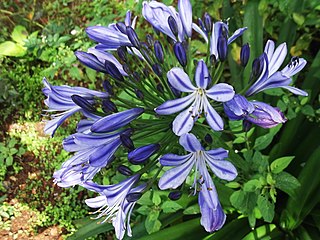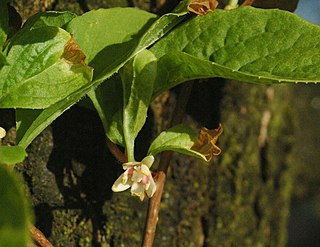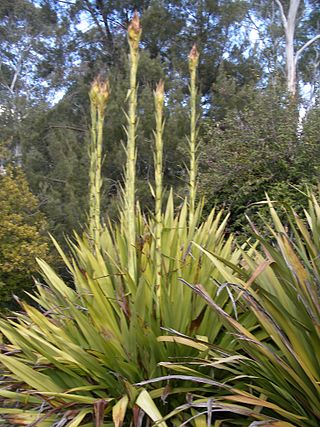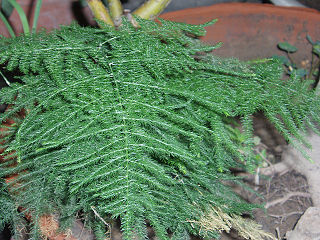
Agavoideae is a subfamily of monocot flowering plants in the family Asparagaceae, order Asparagales. It has previously been treated as a separate family, Agavaceae. The group includes many well-known desert and dry-zone types, such as the agaves and yuccas. About 640 species are placed in around 23 genera; they are widespread in the tropical, subtropical, and warm temperate regions of the world.

Agapanthoideae is a monotypic subfamily of monocot flowering plants in the family Amaryllidaceae, order Asparagales. It is one of three subfamilies of Amaryllidaceae. It was formerly treated as a separate family, Agapanthaceae. The subfamily name is derived from the generic name of the type genus, Agapanthus.

Nolinoideae is a monocot subfamily of the family Asparagaceae in the APG III system of 2009. It used to be treated as a separate family, Ruscaceae s.l. The family name is derived from the generic name of the type genus, Nolina.

Asphodelaceae is a family of flowering plants in the order Asparagales. Such a family has been recognized by most taxonomists, but the circumscription has varied widely. In its current circumscription in the APG IV system, it includes about 40 genera and 900 known species. The type genus is Asphodelus.

Lomandra, commonly known as mat rushes, is a genus of perennial, herbaceous monocots in the family Asparagaceae, subfamily Lomandroideae. There are 51 species, all of which are native to Australia; two of them also extend into New Guinea and New Caledonia.

Schisandraceae is a family of flowering plants with 3 known genera and a total of 92 known species. Such a family has been recognized by most taxonomists, at least for the past several decades. Before that, the plants concerned were assigned to family Magnoliaceae and Illiciaceae.

Asparagaceae, known as the asparagus family, is a family of flowering plants, placed in the order Asparagales of the monocots. The family name is based on the edible garden asparagus, Asparagus officinalis. This family includes both common garden plants as well as common houseplants. The garden plants include asparagus, yucca, bluebell, and hosta, and the houseplants include snake plant, corn cane, spider plant, and plumosus fern.

Myrothamnus is a genus of flowering plants, consisting of two species of small xerophytic shrubs, in the southern parts of tropical Africa and in Madagascar. Myrothamnus is recognized as the only genus in the family Myrothamnaceae.

Aphyllanthes is a genus of flowering plants with only one species, Aphyllanthes monspeliensis, endemic to the western Mediterranean region. It is the only genus in the Aphyllanthoideae, a subfamily of the family Asparagaceae. Aphyllanthoideae was formerly treated as a separate family, Aphyllanthaceae.

Ixiolirion is a genus of flowering plants native to central and southwest Asia, first described as a genus in 1821. Recent classifications place the group in the monogeneric family Ixioliriaceae in the order Asparagales of the monocots. In earlier systems of classification, it was usually placed in the family Amaryllidaceae.

Doryanthes is the sole genus in the flowering plant family Doryanthaceae. The genus consists of two species, D. excelsa and D. palmeri, both endemic natives of the coast of Eastern Australia. Doryanthaceae is part of the order Asparagales.

Asparagoideae is a subfamily of monocot flowering plants in the family Asparagaceae, order Asparagales, according to the APG III system of 2009. The subfamily name is derived from the generic name of the type genus, Asparagus. The group has previously been treated as a separate family Asparagaceae sensu stricto.
Herreriopsis is a monotypic genus of flowering plants in the family Asparagaceae. It is endemic to Madagascar. In the APG III classification system, the genus is placed in the family Asparagaceae, subfamily Agavoideae. The sole species is Herreriopsis elegans.

Hemiphylacus is a genus of flowering plants endemic to Mexico. In the APG III classification system, it is placed in the family Asparagaceae, subfamily Asparagoideae.
Petronymphe is a genus of flowering plants endemic to Mexico. In the APG III classification system, it is placed in the family Asparagaceae, subfamily Brodiaeoideae.

Comospermum is a genus of one species of flowering plant found in southern Japan. In the APG III classification system, it is placed in the family Asparagaceae, subfamily Nolinoideae.

Semele is a genus of flowering plants native to the Canary Islands and Madeira. In the APG III classification system, it is placed in the family Asparagaceae, subfamily Nolinoideae.

Narcisseae is a small tribe of plants belonging to the subfamily Amaryllidoideae of the Amaryllis family (Amaryllidaceae), where it forms part of the Eurasian clade, and is one of three tribes in the European (Mediterranean) clade. It contains two genera and approximately 58 species, but probably also Lapiedra. The two genera are distinguished from each other by the presence of a paraperigonium in the former.
Erinna is a genus of perennial herbaceous geophytes in the flowering plant family Amaryllidaceae. It is native to Chile, South America. It is included in the tribe Gilliesieae, within the subfamily Allioideae. The genus is monotypic, with a single species, Erinna gilliesioides. It is relatively rare.

Crininae is one of four subtribes within the tribe Amaryllideae, with a pantropical distribution (Crinum) and also sub-Saharan Africa.


















